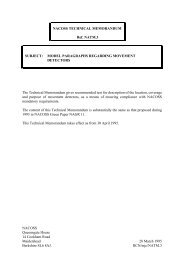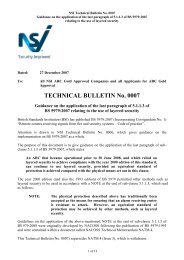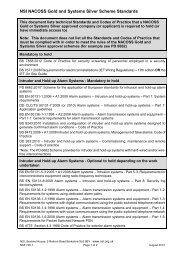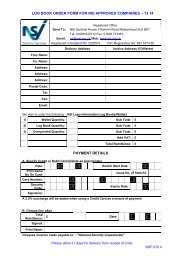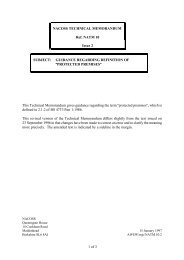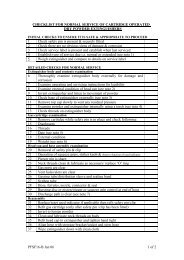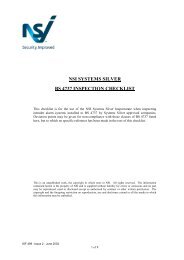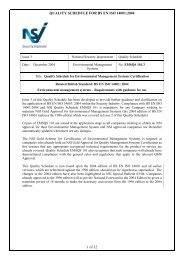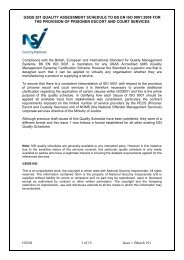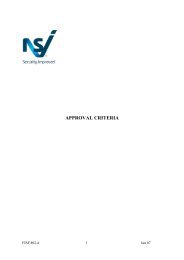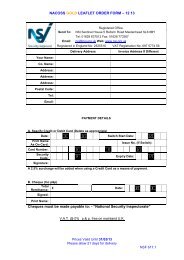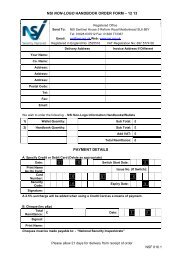NSI Prospectus - National Security Inspectorate
NSI Prospectus - National Security Inspectorate
NSI Prospectus - National Security Inspectorate
Create successful ePaper yourself
Turn your PDF publications into a flip-book with our unique Google optimized e-Paper software.
SF 429.13<br />
NATIONAL SECURITY INSPECTORATE<br />
SCHEME FOR <strong>NSI</strong> ARC GOLD APPROVAL OF<br />
ALARM RECEIVING CENTRES<br />
PROSPECTUS<br />
(as at December 2007)<br />
1. General Introduction and Summary of Criteria for <strong>NSI</strong> ARC Gold Approval<br />
1.1 The applicable Regulations are the <strong>NSI</strong> Regulations. [NAC Regs].<br />
1.2 There are six scopes of approval within the <strong>NSI</strong> ARC Gold approval scheme. All<br />
are based on the application of BS 5979: 2007, as summarised below. Applicants<br />
can elect to apply under any one or more of the five scopes, which are for:<br />
(a)<br />
(b)<br />
(c)<br />
(d)<br />
(e)<br />
(f)<br />
High integrity monitoring of intruder alarms;<br />
Monitoring of intruder alarms (other than high integrity monitoring);<br />
Monitoring of fire alarms;<br />
Monitoring of social alarms;<br />
Monitoring of CCTV systems (see 1.3 below);<br />
SOC monitoring Category 5 after theft systems for vehicle recovery (see<br />
1.4 below).<br />
The expression “high integrity monitoring” (see 1.2 (a) above) is used as a<br />
description of monitoring that is fully in accordance with BS 7042 and the<br />
relevant recommendations set out in BS 5979.<br />
1.3 The scope of approval for monitoring of CCTV systems has two options. An<br />
applicant company may choose to apply for approval in respect of any one of<br />
these options:<br />
1
(i)<br />
RVRC monitoring BS 8418 detector activated CCTV systems and other<br />
CCTV systems used in security applications (BS 5979 Category II); or<br />
(ii) Monitoring of CCTV systems used in non-security applications (BS 5979<br />
Category I).<br />
The abbreviation “RVRC” (see 1.3 (i) above) stands for “Remote Video<br />
Response Centre”, which is a term defined in BS 8418.<br />
1.4 The scope of approval for SOCs monitoring “Category 5” ATSVRs (After Theft<br />
Systems for Vehicle Recovery) is based on a scheme developed by the Motor<br />
Insurance Repair Research Centre (MIRRC) located at Thatcham in Berkshire.<br />
The abbreviation “SOC” (see 1.2 (f) above) stands for “Systems Operating<br />
Centre”, which is a term used in Home Office Scientific Development Branch<br />
(HOSDB) Publication No. 14/02 “Stolen Vehicle Tracking – ACPO and Home<br />
Office Guidance to Companies on Police Policy”.<br />
1.5 A successful application leads to listing in the Official Directory of <strong>NSI</strong> approved<br />
Alarm Receiving Centres (ARCs) and entitlement to use the <strong>NSI</strong> ARC GOLD<br />
logo.<br />
1.6 The Criteria for <strong>NSI</strong> ARC Gold approval are stated in the <strong>NSI</strong> Criteria for<br />
approval [NACP 0].<br />
1.7 The above-mentioned Criteria [NACP 0] require adherence to all the applicable<br />
General Criteria including Criterion 2.3 (Insurances), Criterion 2.4 (Experience of<br />
Management), Criterion 2.5 (Repute of Management) and Criterion 2.6 (Finance).<br />
1.8 The above-mentioned Criteria [NACP 0] require adherence to the following<br />
Codes of Practice and other requirements:<br />
1.8.1 Compliance with the recommendations contained in BS 5979: 2007<br />
(British Standard Code of Practice for Remote centres receiving signals<br />
from fire and security systems) insofar as such recommendations in the<br />
opinion of <strong>NSI</strong> shall reasonably apply.<br />
NOTE:<br />
Compliance with the recommendations applicable for<br />
monitoring of the particular class (or classes) of<br />
monitoring in respect of which you seek approval is<br />
required including:<br />
- for monitoring of intruder alarms, compliance with the<br />
recommendations of BS 5979 applicable to ‘Category II’<br />
centres and compliance with the recommendations of BSI<br />
DD 243 and BS 8473;<br />
- for monitoring of social alarms, compliance with the<br />
recommendations of BS 5979 applicable to ‘Category I’<br />
centres and compliance with the recommendations of<br />
CLC/TS 50134-7;<br />
2
- for monitoring of BS 8418 detector activated CCTV<br />
systems and other CCTV systems used in security<br />
applications (see 1.3 (i) above), compliance with the<br />
recommendations of BS 5979 applicable to ‘Category II’<br />
centres monitoring CCTV systems and compliance with<br />
the recommendations of BS 8418.<br />
NOTE REGARDING BS 8418: 2003<br />
BS 8418: 2003 calls up recommendations contained within British<br />
Standard Code of Practice BS 7958 and BSI Published Document PD<br />
0008 (now superseded by BSI BIP 0008).<br />
- for monitoring of CCTV systems used in non-security<br />
applications (see 1.3 (ii) above), compliance with the<br />
recommendations of BS 5979 applicable to ‘Category I’<br />
centres monitoring CCTV systems.<br />
- for monitoring of ATSVRs (see 1.4 above), compliance<br />
with the recommendations of BS 5979 applicable to<br />
‘Category II’ centres and compliance with Thatcham’s<br />
“Category 5” Criteria for SOCs and HOSDB Publication<br />
14/02.<br />
1.8.2 Compliance with BS 7858 (British Standard Code of Practice for <strong>Security</strong><br />
Screening of Personnel Employed in a <strong>Security</strong> Environment).<br />
NOTE:<br />
All applicant companies need to be aware of the<br />
significance that <strong>NSI</strong> places on the security screening of<br />
both the principals and staff. Applicant companies need<br />
to set up and implement a formal security screening<br />
procedure to BS 7858 (with all its attendant<br />
documentation) prior to application, (or to have completed<br />
this before approval is awarded).<br />
Directors, partners and proprietors of applicant companies<br />
(and any persons holding 10% or more of the shares of the<br />
applicant company) are security screened by <strong>NSI</strong> (as are<br />
the persons nominated to be Qualifying Managers and the<br />
person nominated to be responsible for carrying out<br />
security screening within the applicant company). All of<br />
the above need to submit fully completed Personal Data<br />
Questionnaires (Form NSF 450) to <strong>NSI</strong> in order for the<br />
application to proceed.<br />
1.8.3 Compliance with NACP 2 (<strong>NSI</strong> Code of Practice for Customer<br />
Communications).<br />
1.8.4 Compliance with NACP 3 (Issue 2) (<strong>NSI</strong> Code of Practice for<br />
Management of Sub-contracting).<br />
3
1.8.5 Compliance with NACP 5 (<strong>NSI</strong> Code of Practice for Management of<br />
Customer Complaints).<br />
1.8.6 Compliance with <strong>NSI</strong> Quality Management System requirements as set<br />
out in Section 1.9 below.<br />
(The above is a summary. It is not exhaustive and it does not include all the<br />
normal criteria. Reference should be made to the published “Criteria for<br />
Recognition” booklet [NACP 0].)<br />
1.9 The above-mentioned Criteria [NACP 0] require that ARCs shall implement and<br />
maintain a Quality Management System complying with BS EN ISO 9001: 2000<br />
and <strong>NSI</strong> Quality Schedule SSQS 102, which will be assessed by <strong>NSI</strong> as part of<br />
the application for <strong>NSI</strong> ARC Gold approval.<br />
2. Application Procedure<br />
2.1 Submit completed application form [SF 428], all supporting documentation and<br />
application fee to <strong>NSI</strong> at Sentinel House. This documentation needs to include a<br />
copy of the applicant company’s Quality Manual and Procedures. It is important<br />
that the content of these manuals is sufficient for the Application to be further<br />
progressed.<br />
2.2 It is likely that there will some correspondence between <strong>NSI</strong> and the applicant<br />
company regarding security screening of personnel and other matters (see 1.8.2<br />
above).<br />
2.3 An inspection visit will be arranged by appointment, for the purpose of assessing<br />
compliance with BS EN ISO 9001, SSQS 102, BS 5979, other documents such as<br />
BS EN 50134-7 and BS 8418 where applicable, and the other requirements of the<br />
Scheme including compliance with relevant <strong>NSI</strong> Codes of Practice and <strong>NSI</strong><br />
Directives. The visit normally involves two Inspectors and lasts a full day.<br />
2.4 If improvement needs are found, the applicant company will be advised<br />
accordingly and should take appropriate corrective actions. When the company<br />
advises that all matters have been attended to, a second inspection visit may be<br />
arranged depending on the nature and extent of the improvement needs observed.<br />
There is an additional fee if a second visit is required to complete the process.<br />
2.5 Where improvement needs against certain of the constructional requirements of<br />
Clause 5 of BS 5979: 2007 are identified during the first visit, the applicant<br />
company may be able to invoke the paragraph at the end of sub-clause 5.1.1.3,<br />
which states:<br />
An ARC that became operational prior to 30 June 2008, and<br />
which relied on layered security to achieve compliance with the<br />
year 2000 edition of this standard, can continue to use layered<br />
security, provided an equivalent standard of protection is<br />
achieved compared with the physical means set out in 5.1.1.3.<br />
4
2.6 Where an ARC wishes to rely on the 'layered security option' permitted by the last<br />
paragraph of sub-clause 5.1.1.3 of BS 5979: 2007, the company must demonstrate<br />
to the satisfaction of <strong>NSI</strong> that the Alarm Receiving Centre (ARC) became<br />
operational before 30 June 2008 and that plans to develop the ARC were drawn<br />
up based on the content of BS 5979: 2000 (i.e. prior to BS 5979:2007 being<br />
published). The company must also supply a dossier setting out full details of<br />
layered security proposals explaining how a standard of protection equivalent to<br />
that which has been traditionally accepted is intended be achieved.<br />
2.7 Any applicant company using the layered security option should refer to <strong>NSI</strong><br />
Technical Bulletin 0007, copies of which may be obtained on request from<br />
Sentinel House.<br />
2.8 <strong>NSI</strong> Technical Bulletin 0007 gives guidance on the procedure adopted by <strong>NSI</strong> for<br />
those applicants wishing to use layered security. Please understand, however, that<br />
an election to opt for the layered security route is likely to entail an additional<br />
visit, at additional cost to your company.<br />
3. Award of Certificate<br />
4. Advice<br />
3.1 An <strong>NSI</strong> Certificate (issued by <strong>NSI</strong> to an approved company) normally runs to the<br />
end of the financial year (i.e. 31 st March) during which it was issued. At the yearend,<br />
it is normally renewable upon payment of an annual renewal fee.<br />
3.2 During the life of the certificate, routine surveillance visits are made to the ARC<br />
from time to time, to verify continued compliance with the requirements of the<br />
Scheme. These visits are normally made annually and are chargeable in addition<br />
to the annual renewal fee.<br />
3.3 Every effort is made to combine the BS EN ISO 9001 and the BS 5979 routine<br />
surveillance visits.<br />
3.4 <strong>NSI</strong> preserves a right to make additional visits at its sole discretion, chargeable to<br />
the company that operates the ARC.<br />
4.1 We are normally happy to discuss the application of particular clauses of BS<br />
5979, either at an informal site meeting (e.g. during construction of the alarm<br />
receiving centre) or by reference to plans and drawings at an office meeting.<br />
Such meetings may be arranged either before a formal application is submitted, or<br />
during the application process. Companies requesting such an advisory meeting<br />
are asked to note that:<br />
(i)<br />
(ii)<br />
A fee is payable (in addition to the normal application fee);<br />
Priority is given to official inspection visits and the processing of<br />
applications. While <strong>NSI</strong> will normally use its best endeavours to<br />
accommodate advisory visits where these are requested, <strong>NSI</strong> does<br />
preserve an absolute right to refuse or defer an advisory visit, with or<br />
without giving reasons;<br />
5
(iii)<br />
(iv)<br />
While advice is offered in good faith, responsibility is not accepted and<br />
indications given during an advisory visit do not bind us as to the<br />
determination of an application for approval;<br />
Companies which have received an advisory meeting/visit, or which have<br />
submitted plans or other information are not thereby regarded as having<br />
made an application for approval, and will not be regarded as Applicants<br />
under the Scheme until they have submitted completed application form<br />
(SF 428), together with the application fee and supporting documents.<br />
5. Fire Detection Systems for Alarm Receiving Centres<br />
Attention is drawn to sub-clause 5.1.8.3 of BS 5979: 2007 which calls for the whole of<br />
the building housing an ARC to be supervised by an automatic fire detection system<br />
complying with Type P1/M of BS 5839: Part 1: 2002, or by an automatic sprinkler<br />
system, (except where the conditions set out in the NOTES at the end of 5.1.8.3 are<br />
satisfied).<br />
********************************<br />
SF 429.13 December 2007<br />
6



